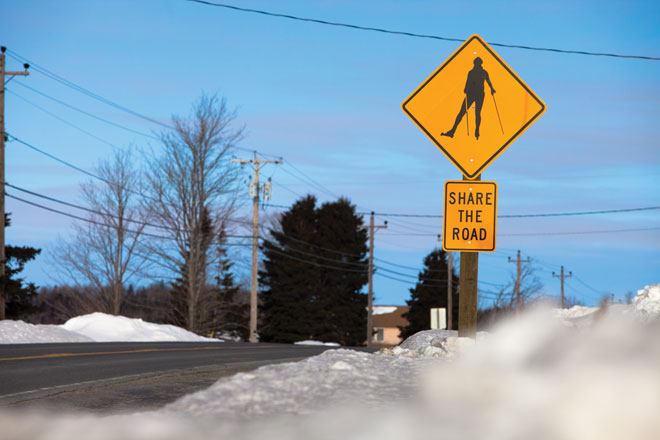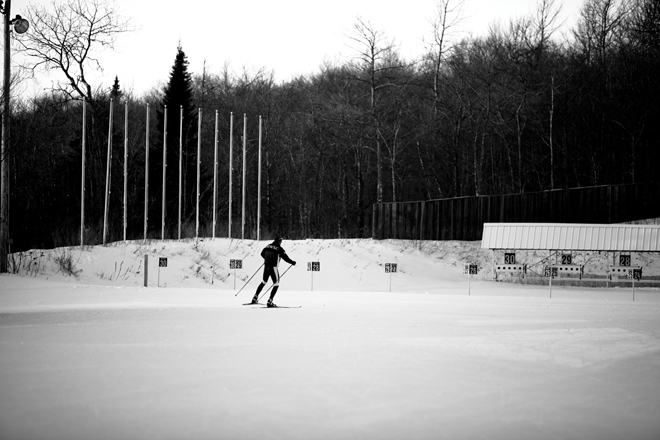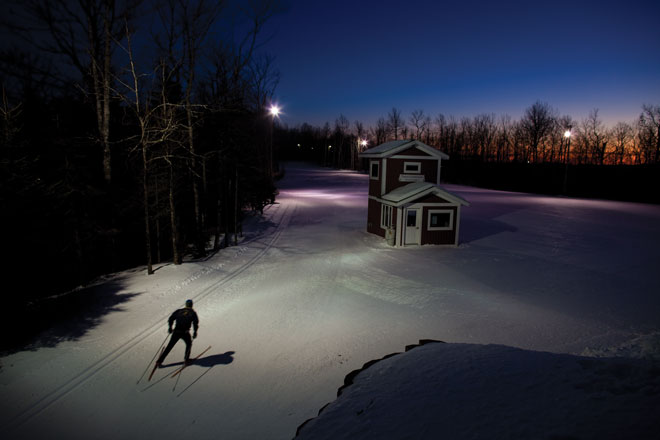The Nordic Heritage Center is a X-Country Skiers Paradise
March 2010
By Sarah E. Getchell
Photographs by Nick LaVecchia + Tim Doak
Deep in the wild expanse of the northern Maine woods, there is a red Swedish-style lodge that lures both Olympic athletes and recreational skiers to Presque Isle. It’s 300 miles from Portland, a stone’s throw from Canada, and in the northeastern corner of the largest, least-populated county east of the Mississippi.
It’s a place with over twenty kilometers of trails that wind through the forest. Boots dry on a stone hearth that evokes the feel of European ski chalets. Antique skis and poles made by local artisans adorn the walls. Large windows offer a 360-degree view of the trails that loop around the lodge.
Outside, kids yell to each other as they learn to balance on skis in the open field near the lodge. Old friends ski together up the flawless corduroy, zooming down the perfectly cut trails that are windy enough to be fun but angled gently enough for speedy descents. The place is brimming with small-town vibes and Olympic hopes.
These hopes are quickly becoming reality for athletes who have trained at the Nordic Heritage Center and at its sister venue, the 10th Mountain Ski Club in Fort Kent. Of the nine skiers on the U.S. biathlon team that competed in the Vancouver Olympics, six have lived and trained in Aroostook County. Tim Burke, one of the six, was ranked number one in the world last month and has a chance to bring the United States its first Olympic biathlon medal.
Aroostook is well known inside the insular world of cross-country skiing. “Nordies” all over the world are adding Aroostook to their lists of must-visit ski destinations. The Nordic Heritage Center and 10th Mountain are household names in parts of Europe, where millions of viewers tune in live to watch skiing in Aroostook.
In 2004, 10th Mountain held a World Cup Biathlon race, and elite athletes from all over the world came to County towns. Twenty thousand spectators cheered the athletes on, and over 700 locals volunteered at the event. The Swedish team spoke Swedish with the older residents of nearby New Sweden, and the French team could communicate with the large French-speaking population in and around Fort Kent. Races in Europe have taken place in small towns with local support for hundreds of years, so it’s not surprising that European racers feel at home in Aroostook.
THE ORIGINS
In 1998, Andy Shepard, a former L.L. Bean executive, decided that skiing rather than manufacturing might be the path to economic renewal for Aroostook. He was frustrated by the increasing difficulty sourcing products from Maine for L.L. Bean. He was struck by the similarities between the economic issues that faced Joshua Chamberlain in the 19th century and those that faced Angus King in the 1990s—threats to manufacturing jobs and factory closures. For over 100 years, Maine had been trying to replace lost manufacturing jobs with new manufacturing jobs. Shepard says, “Since our problems hadn’t changed, our solutions had to.”
His answer for Maine’s hurting rural communities? Nordic skiing.
The County is sometimes seen as a place where there are more snowmobiles than cars, more potatoes than people, and more teen smokers than teen athletes—not an obvsious place for a Nordic ski mecca. But Shepard realized that there was great potential in the rich history of skiing in the area coupled with the area’s reliable snow conditions.
Though a novel answer to modern economic problems, it wasn’t the first time that skiing had been considered as a solution to northern Maine’s economic woes. In 1870, Joshua Chamberlain recruited 21 families from Stockholm, Sweden, to settle near Presque Isle, feeling that these rugged winter people were likely to thrive in the area. The Swedes quickly built roads, established communities, and skied everywhere. They skied for fun and for transportation, and they crafted wooden skis, which they taught the locals to use. Northern Mainers were soon throwing winter carnivals, which included sprint races, jumping competitions, and marathon races as long 180 miles.
In 1999, after hearing Shepard’s pitch, Portland’s philanthropic Libra Foundation founded the Maine Winter Sports Center, which operates the Nordic Heritage Center and five other ski destinations. As part of the decision process, Owen Wells, Libra’s president and CEO, met with the president of the U.S. Biathlon Association to discuss the creation of a ski mecca in Maine. Wells had never heard of biathlon, but the president told him that snow studies had shown that northern Maine had the most consistent snow coverage in the U.S. outside of Alaska.
Wells, former governor Angus King, the biathlon president, and representatives from the ski community flew into the defunct Loring Air Force Base to begin the search for the right place to build world-class ski trails. “We could’ve landed sideways on the runway, it was so wide,” Wells says. Once they landed, everyone had long faces: the area around the base was too flat, and they needed undulating terrain. Undaunted, they visited Presque Isle and Fort Kent and found two perfect places for the ski centers.
The Heritage Center was built just a few miles from Main Street in Presque Isle. The trails were designed by John Morton, whose design resume includes the Cairngorms National Park in the Scottish Highlands and the ski trails for the Korean World University Games.
“There were a lot of people who questioned why an investment should be made in a place that is so remote,” Andy Shepard says. He remained convinced. The idea was that if you
build it, they will come. They will come with skis, Spandex suits, and their wallets. Against the odds, the plan appears to be working.
BLAZING NEW TRAILS
In 2004, 150 athletes from 23 countries attended the Biathlon World Cup. Two new restaurants opened—Slopes in Presque Isle and Swamp Buck in Fort Kent—banking on the economic success of the center. In 2006, 226 athletes from 28 countries attended the World Junior Championships, and local businesses reported that the race weekend was one of their busiest weekends in history. In 2009, Jeff Dubis, a professor of forestry at the University of Maine at Fort Kent, launched a business degree program for winter sport. Within the last few months a well-appointed Hampton Inn opened in Presque Isle and it’s frequently booked.
This March, the Nordic Heritage Center will host the Junior Olympics, drawing hundreds of the best young skiers in the United States to the northern Maine woods. Shepard anticipates an influx of as many as 1,500 people into Presque Isle for eight to ten days. “Every hotel bed in Presque Isle and Caribou will be full,” he says. “In this kind of economy, that’s very important for these places.”
People from all over New England are discovering the pristine beauty of Presque Isle and ski trails that are among the finest in the world. Wells says that the ski centers have helped close the physical and economic gaps between north and south. “You don’t hear about two Maines anymore,” he says.
Ask anyone in Presque Isle about the center and you are likely to get an excited earful. “Nordic skiing,” a somewhat esoteric term for all types of skiing in which the heel of the boot is not fixed to the ski, is a part of the native tongue. Tim Doak, a native of Caribou and a devoted volunteer at the center, excitedly talks about the 100 students that have joined the local middle school ski team and about the fact that there are more licensed biathlon officials per capita here than anywhere else in the United States.
Doak wears many hats. Like the many locals who are the lifeblood of the two ski venues, he devotes countless hours to the center as a volunteer. Doak is also a trustee of the ski club and the event director for the upcoming Junior Olympics races. Despite doing so much he is quick to share credit for the venue’s success. He says that the communities have embraced the centers to an incredible degree; in addition to all of the volunteer support provided by the local people, the Rotary Club purchased the lights and mechanical biathlon targets for the center, which totaled over $60,000.
Doak is also the engineer who designed the center’s lodge. He consulted descendents of the original Swedish community at each stage of his design process. He even obtained a can of the traditional red paint used to paint ski lodges in Sweden, which he matched exactly for the outside of this lodge. Inside he designed a dining area, a stone fireplace, and a sauna as well as locker rooms and sleeping quarters for athletes.
All of these luxuries and some of the best skiing that can be found anywhere in the world are available here free of charge. Shepard says, “As soon as people have made their first trip to the County the distance issue will evaporate.” The Nordic Heritage Center is undeniably worth the drive.
Rte. 167 | Presque Isle | 207.762.6972 | nordicheritagecenter.org | mainewsc.org
John Attwood, Cape Elizabeth
Doctor, lifelong skier, masters racer
I’ve visited just to ski and to watch my daughter compete. The lodge was impressive; it was a wonderful mix of high-tech and homespun. I skied every trail there and found them to be beautiful and challenging. The corners were tight and perfectly designed such that you can go fast down the hills but you don’t kill yourself.
Eileen Carey, Caribou
Vice president of the Maine Winter Sports Center, coach, former Dartmouth College ski racer
Gary, the biathlon coach, travels to the Fogg Farm in Freeport for biathlon clinics and has discovered a group of kids and families in southern Maine that are completely psyched about biathlon. They come up for training and racing. There’s a big group of 12- to 14-year-olds that are trying to convince their parents to move to northern Maine because they love it up there.
Austin Ross, Madawaska
Ski coach, former Colby College ski racer
So many southern Mainers think that northern Maine is all snowmobile hicks until they visit and discover the beautiful snow, the great ski and bike trails, and the amazingly friendly people. I’ve been impressed by how well the snowmobilers here work with the skiers. They realize that the Nordic trails are not just recreation, they’re revitalizing the town, and they do a lot to help out.
Roger Knight, Portland
Director of Team and Eastern Operations for Boulder Nordic Sport, ski and wax guru
The race venues in northern Maine have done amazing things for the sport and for kids from a racing and a nonracing perspective. I’d like to see the extension of these programs in western Maine. The kids in Rumford could use a program like this, where they can get access to equipment for a small amount of money.
Walt Shepard, Yarmouth
World-class biathlete, Maine Winter Sports Center athlete, Bowdoin College student
After I graduated from high school in 2001, I moved up to Fort Kent and lived at the the 10th Mountain Lodge. I was MWSC’s first funded athlete, and at that time, they hadn’t exactly figured out what that should look like. For instance, allowing athletes to live at the lodge was an unanticipated scenario, but it gave me a roof over my head. The week I moved in crews were still installing floor tiles, lights, shower heads, and there wasn’t a single piece of furniture in the place, except for my inflatable mattress and fold-out lawn chair!
To me, that drive to be a force for good in people’s lives is the essence of the Maine Winter Sports Center. The dream is that someone who trains there might step up on an Olympic podium, but the goal is for everyone involved to lead better, more fulfilling lives. That has certainly been the case for me.








